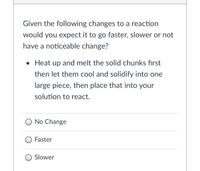
General Chemistry - Standalone book (MindTap Course List)
11th Edition
ISBN: 9781305580343
Author: Steven D. Gammon, Ebbing, Darrell Ebbing, Steven D., Darrell; Gammon, Darrell Ebbing; Steven D. Gammon, Darrell D.; Gammon, Ebbing; Steven D. Gammon; Darrell
Publisher: Cengage Learning
expand_more
expand_more
format_list_bulleted
Question
6

Transcribed Image Text:Given the following changes to a reaction
would you expect it to go faster, slower or not
have a noticeable change?
• Heat up and melt the solid chunks fırst
then let them cool and solidify into one
large piece, then place that into your
solution to react.
O No Change
O Faster
O Slower
Expert Solution
This question has been solved!
Explore an expertly crafted, step-by-step solution for a thorough understanding of key concepts.
This is a popular solution
Trending nowThis is a popular solution!
Step by stepSolved in 2 steps

Knowledge Booster
Learn more about
Need a deep-dive on the concept behind this application? Look no further. Learn more about this topic, chemistry and related others by exploring similar questions and additional content below.Similar questions
- . Hydrogen gas and chlorine gas in the presence of light react explosively to form hydrogen chloride H2(g)+Cl2(g)2HCl(g)The reaction is strongly exothermic. Would an increase in temperature for the system lend to favor or disfavor the production of hydrogen chloride?arrow_forwardOld-fashioned smelling salts consist of ammonium carbonate, (NH4)2CO3. The reaction for the decomposition of ammonium carbonate (NH4)2CO3(s)2NH3(g)+CO(g)+H2O(g) is endothermic. Would the smell of ammonia increase or decrease as the temperature is increased?arrow_forwardSubstances that poison a catalyst pose a major concern for many engineering designs, including those for catalytic converters. One design option is to add materials that react with potential poisons before they reach the catalyst. Among the commonly encountered catalyst poisons are silicon and phosphorus, which typically form phosphate or silicate ions in the oxidizing environment of an engine. Group 2 elements are added to the catalyst to react with these contaminants before they reach the working portion of the catalytic converter. If estimates show that a catalytic converter will be exposed to 625 g of silicon during its lifetime, what mass of beryllium would need to be included in the design?arrow_forward
- a What happens to a reaction rate as temperature drops? Give two explanations for the change. State which one is more important and explain why. b How does a catalyst affect reaction rates? c Compare reaction rates when a given reactant concentration is high with the rate when the concentration is low. Explain the difference.arrow_forwardThe following equation represents a reversible decomposition: CaCO3(s)CaO(s)+CO2(g) Under what conditions will decomposition in a closed container proceed to completion so that no CaCO3 remains?arrow_forwardWhy are there no changes specified for Ni in Exercise 13.61, part (f)? What property of Ni does change?arrow_forward
- Explain why each of the following chemical equations is not a correct formation reaction: 4Al( s )+3 O 2 ( g )2 Al 2 O 3 ( s ) N 2 ( g )+ 3 2 H 2 ( g ) NH 3 ( g ) 2Na( s )+O( g ) Na 2 O( s )arrow_forward. Consider the exothermic reaction CO(g)+2H2(g)CH3OH(l)Predict three changes that could be made to the system that would decrease the yield of product over that produced by a system in which no change was made.arrow_forwardThe recycling of polymers represents only one industrial process that allows creating order in one location by creating greater disorder at some other location, often at a power plant. List three other industrial processes that must create disorder in the surroundings to generate the desired material.arrow_forward
- 9.75 Explain why each of the following chemical equations is not a correct formation reaction. (a) 4Al(s)+3O2(g)2Al2O3(s) (b) N2(g)+32H2(g)NH3(g) (c) 2Na(s)+O(g)Na2O(s)arrow_forwardConsider the reaction N2O4(g)2NO2(g). Would you expect this reaction to be endothermic or exothermic? Why? N2O4 is a colorless gas; NO2 is red-brown. Would you expect a mixture of these gases to become more or less red-brown as you raise the temperature? Explain.arrow_forwardClassify the following processes as exergonic or endergonic. Explain your answers. a.Any combustion process b.Perspiration evaporation from the skin c.Melted lead solidifying d.An explosive detonating e.An automobile being pushed up a slight hill from point of view of the automobilearrow_forward
arrow_back_ios
SEE MORE QUESTIONS
arrow_forward_ios
Recommended textbooks for you
 General Chemistry - Standalone book (MindTap Cour...ChemistryISBN:9781305580343Author:Steven D. Gammon, Ebbing, Darrell Ebbing, Steven D., Darrell; Gammon, Darrell Ebbing; Steven D. Gammon, Darrell D.; Gammon, Ebbing; Steven D. Gammon; DarrellPublisher:Cengage Learning
General Chemistry - Standalone book (MindTap Cour...ChemistryISBN:9781305580343Author:Steven D. Gammon, Ebbing, Darrell Ebbing, Steven D., Darrell; Gammon, Darrell Ebbing; Steven D. Gammon, Darrell D.; Gammon, Ebbing; Steven D. Gammon; DarrellPublisher:Cengage Learning Living By Chemistry: First Edition TextbookChemistryISBN:9781559539418Author:Angelica StacyPublisher:MAC HIGHER
Living By Chemistry: First Edition TextbookChemistryISBN:9781559539418Author:Angelica StacyPublisher:MAC HIGHER Introductory Chemistry: A FoundationChemistryISBN:9781337399425Author:Steven S. Zumdahl, Donald J. DeCostePublisher:Cengage Learning
Introductory Chemistry: A FoundationChemistryISBN:9781337399425Author:Steven S. Zumdahl, Donald J. DeCostePublisher:Cengage Learning ChemistryChemistryISBN:9781305957404Author:Steven S. Zumdahl, Susan A. Zumdahl, Donald J. DeCostePublisher:Cengage Learning
ChemistryChemistryISBN:9781305957404Author:Steven S. Zumdahl, Susan A. Zumdahl, Donald J. DeCostePublisher:Cengage Learning Chemistry: An Atoms First ApproachChemistryISBN:9781305079243Author:Steven S. Zumdahl, Susan A. ZumdahlPublisher:Cengage Learning
Chemistry: An Atoms First ApproachChemistryISBN:9781305079243Author:Steven S. Zumdahl, Susan A. ZumdahlPublisher:Cengage Learning

General Chemistry - Standalone book (MindTap Cour...
Chemistry
ISBN:9781305580343
Author:Steven D. Gammon, Ebbing, Darrell Ebbing, Steven D., Darrell; Gammon, Darrell Ebbing; Steven D. Gammon, Darrell D.; Gammon, Ebbing; Steven D. Gammon; Darrell
Publisher:Cengage Learning

Living By Chemistry: First Edition Textbook
Chemistry
ISBN:9781559539418
Author:Angelica Stacy
Publisher:MAC HIGHER

Introductory Chemistry: A Foundation
Chemistry
ISBN:9781337399425
Author:Steven S. Zumdahl, Donald J. DeCoste
Publisher:Cengage Learning

Chemistry
Chemistry
ISBN:9781305957404
Author:Steven S. Zumdahl, Susan A. Zumdahl, Donald J. DeCoste
Publisher:Cengage Learning

Chemistry: An Atoms First Approach
Chemistry
ISBN:9781305079243
Author:Steven S. Zumdahl, Susan A. Zumdahl
Publisher:Cengage Learning
